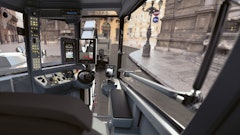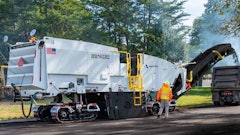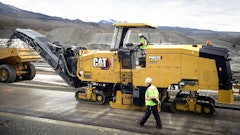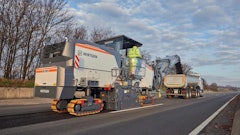
Reconstruction of the 14,572-foot Bay Runway at John F. Kennedy International Airport comes about as close as you can get today to an automated construction project, if you just look at the equipment. Milling, grading, and 280,000 tons of asphalt shoulder paving were supported by Topcon automated machine controls, and Gomaco concrete pavers controlled by Leica Geosystems laid 175,000 cubic yards on the runway with no stringline.
Working under a $204-million contract, Tutor Perini Corp. and subcontractor Intercounty Paving widened JFK's Bay Runway (13R-31L) – one of the nation's longest commercial runways – from 150 to 200 feet. They milled off 6 inches of existing asphalt, built new taxiways, reconstructed numerous intersecting taxiways, and did the shoulder work – notably paving an 80-foot wide asphalt shoulder. Tutor Perini, of Sylmar, Calif., topped off the runway with 18 inches of Portland Cement Concrete.
Grade-control automation was essential to satisfying a very tight schedule. The Port Authority of New York and New Jersey closed the runway from March 1 to June 28, while the contractors completed more than 10,000 feet of runway.
Tutor Perini Project Manager Damon Petrillo says the firm bid the job planning to use machine control in all phases. "There is an initial investment in the equipment," says Petrillo. "And we look at it as a no-brainer in terms of a huge savings in time."
At Intercounty, general manager Frank Lizza says the Topcon machine controls slashed weeks from the milling schedule, compared to using staking and manual controls. "We would never have gotten the job done without it," says Lizza.
"The biggest thing that this project benefited from was that we had one central source for the data," says Steve Thomas, a partner at MESH Consulting LLC, Limerick. MESH provided the contractors with a single digital terrain model to guide all of the grade-control and surveying systems on the project. The terrain model is a digitized 3D model of the runway. "We had numerous subcontractors on the project, but everybody used that same data. It was all run through the surveyors for Tutor Perini. They were the keepers of the data.
"When anything was laid out at the site, it was done using our one central model of the site," says Thomas of MESH. "That is not only surfaces, but it also included the horizontal layout of all the concrete joints, all of the light cans involved, and all the striping and pavement markings.
Thomas says the first step in construction was to build a number of new drainage systems. Those systems were all included in the digital model for all of the pipe crews and surveyors laying out the drainage works. Then some electrical systems were rerouted.
The next step was to mill the existing asphalt to exactly 18 inches below finished grade, which meant shaving off about 6 inches. "They were able to take our finished grade model, put that into the milling machines, and without doing any kind of staking or marking on the existing runway, they were able to mill to exactly 18 inches below finished grade," says Thomas.
To handle the milling, Intercounty brought in six Roadtec RX900 milling machines, each capable of milling 12 feet wide. But cutting 6 inches deep created too much vibration for Topcon's Millimeter GPS system to work accurately.
"When we were cutting 6 inches deep, it would vibrate the milling drum somewhat violently at times because of the hardness of asphalt we were milling," says Lizza. "We would have to stop and reset the machine due to the satellite dishes swaying."
The answer: do the milling in two stages, 4 inches first, then 1.5 to 2 inches in a second stage.
For the 4-inch cut, Intercounty ran three Roadtec RX900 milling machines in "RTK Mode" – without the laser cross-reference for millimeter accuracy – and "bulked out" material to -1.36 foot below finished grade. "We decided to come back later with the Millimeter component and profile mill the remaining 1.5 to 2 inch cut, said Lizza.
"We found that actually worked faster because the bulking machines weren't waiting for laser set up, and reduced vibration wasn't causing distortions in the grid pattern during the laser controlled Millimeter milling," says Lizza. "The final cuts were much more accurate than what we started out with because we had less vibration and less down time. Because two-thirds of the material was already gone, the machines would operate at a much faster rate."
Lizza said that Intercounty ran Millimeter GPS systems on several of the milling machines in echelon. The first fine milling machine would make the virgin cut with MMGPS receivers on both sides. The trailing machine would match the cut with the Roadtec hydromation system on one side while cutting a new grade with MMGPS on the other.
Topcon dealer Jim Cleary of Cleary Machinery supplied machines and product support to both Intercounty and Tutor Perini at JFK. Cleary said Tutor Perini ran two Topcon GPS machines on a CAT D8 Dozer and 14H Grader. Meanwhile Intercounty shuttled their four GPS machines between the six milling machines, four pavers, two D6N dozers, and a Komatsu Grader.
"GPS machine control drove this job from the opening day," Cleary said. "The entire runway was milled without a single mark on the ground, faster and more accurately with MMGPS. This enabled the Port Authority to achieve their goal of exactly 18 inches of concrete within a very tight tolerance."
For asphalt paving, Intercounty used three Caterpillar 1055 pavers and one Caterpillar 655 paver. "We used two every single day and then on weekends we used three," says Lizza. "On one day we used four pavers. We ran three just on the 80-foot shoulder and ran a fourth one on a taxiway on the other side of the airport. The asphalt was produced by three different facilities."
Lizza said the Topcon Paver System Five with SAS Ski's worked very well for the asphalt paving. "The biggest reason I went with them is for the rideability spec," Lizza said. "The Port Authority doesn't allow anything that is out of tolerance by more than a quarter inch in 25 feet. If you're out of tolerance you have to come back and diamond grind it. I don't want to say we had no grinding, but we had very, very little grinding."
Asphalt paving began on March 20, and by June 29, Intercounty had paved more than 260,000 tons. "We paved a year's worth of production in 100 days," says Lizza.
For the concrete paving, Tutor Perini used two pavers, a four-track Gomaco GP 4000 and a two-track Gomaco GP 2800. Both pavers were set up with automated guidance systems from Leica Geosystems; the contractor ran the GP 4000 during the day and the GP 2800 at night. Petrillo said Tutor Perini gave the GP 4000 the nights off for cleaning and maintenance. Both pavers ran 25 feet wide, so it took eight lanes to cover the 200-foot wide runway.
Concrete paving started in mid-March, and wrapped up by the beginning of June on the 10,000-foot section, which amounted to some 175,000 cubic yards of concrete.
"Our concrete paving went very well," said Petrillo. "Timing was everything. "This is where the Leica system and the computer model saved us a great deal of time, by saving the labor it takes to go out and put up stringline and have surveyors doing staking. We had our own concrete plant on site."
Tutor Perini controlled the concrete pavers with two Leica robotic total stations, and maintained a third robotic total station in line for a spare. And at times if one of the robotic total stations was prevented from sending a signal to the paver, the third one could swing into action.
The Leica system regulates steering, grade, draft and crossfall of the slipform paver in real time, and integrates seamlessly to the paver with no need to install complex retrofit hydraulics.
The automatic paver control system bases its guidance on a digital terrain model – a digitized 3D model of the runway – that is entered into a Leica computer onboard the paver. The paver also has two prisms, mounted above the machine, to receive signals from the two robotic total stations set up on tripods ahead of the paver. The prisms on the paver have a relation to four points on the slipform concrete paver's pan, which extrudes concrete for the runway.
When setting up the two total stations, a technician back-sights each of them to three known control points. That fixes the location of the total stations relative to the runway's digital model. The total stations can then "see" two prisms on the paver and communicate to the paver – by free-wave radio – the paver's precise location. The on-board computer then processes the differences between the actual paver location and the digital terrain model. Knowing those differences, the computer controls the paver pan location automatically.




















![Screen Shot 2023 01 04 At 5 23 30 Pm[35]](https://img.forconstructionpros.com/files/base/acbm/fcp/image/2023/01/Screen_Shot_2023_01_04_at_5.23.30_PM_35_.63bc42696de27.png?auto=format%2Ccompress&fit=crop&h=135&q=70&w=240)


![Bm 2200 65 Cold Planer Release[17]](https://img.forconstructionpros.com/files/base/acbm/fcp/image/2023/06/BM_2200_65_Cold_Planer_release_17_.649359d81b660.png?auto=format%2Ccompress&fit=crop&h=135&q=70&w=240)





